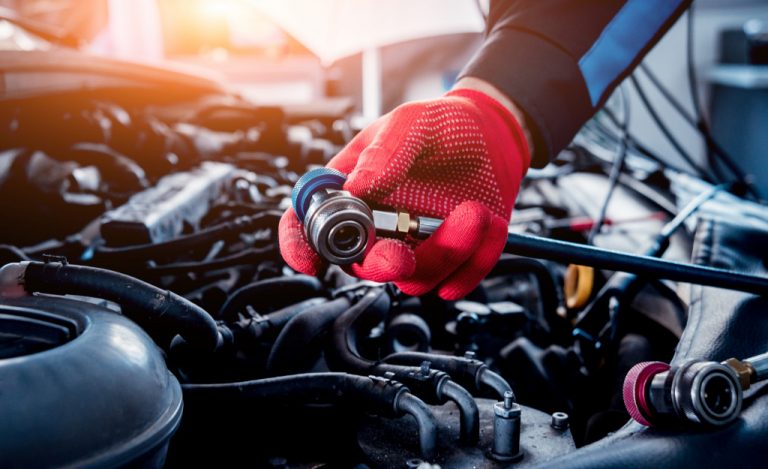The powertrain system on a car is an impressive feat of engineering. Understanding how all these components work together enables mechanics to diagnose problems that can be mild to severe and widespread over the entire vehicle.
What Are Powertrains?
The heart of a vehicle is its powertrain, which includes the engine and transmission and all other parts that deliver power from those two components to the wheels. In hybrid vehicles, a third element called an electric motor-generator might also be part of the powertrain, especially if it routes electricity through a battery for storage before driving the wheels.
Powertrain components can also include the following:
- Torque Converters – which can multiply engine torque as necessary by locking a stationary clutch to the rotating driveshaft
- Axles – which connect the transmission and wheels
- Drive Axles – which transmit power from the transmission to drive axles that send it to the wheels
- Differential Gears – which channel power from both drive axles into one or two spinning driveshafts
- Final Drives – which use gears to reduce the speed of the spinning driveshaft so that it matches the speed of the drive wheels
- Chassis – which provide basic support for powertrain components, steering linkage, and suspension
- Seals – which keep oil inside an engine or transmission rather than all over a vehicle’s interior
- Bearings – which help rotating parts spin smoothly and quietly
- Batteries – which store electricity for use by electric motors
- Electric Motor-Generators – which can function as power sources or as part of a vehicle’s powertrain, especially if they provide electricity to the battery and electric motor
- Fuel Pumps – which help deliver fuel from a tank to an engine
- Charge Pumps – which help deliver electricity from a battery to an electric motor or electric motor-generator
What Is a Powertrain Control Module?
The PCM is the computer that’s part of every engine and transmission. It monitors input from sensors all over the engine and transmission systems and then sends output to control fuel injection, spark plugs, and other sources of ignition. PCM-controlled devices also include the starter, alternator, and fuel pump.
The PCM ensures that all of these components work together smoothly so that a vehicle performs at peak efficiency – whether it’s a hybrid or a more conventional model with a gasoline engine.
For example, when an engine is operating in “drive,” the PCM keeps track of its speed and uses that information to decide when to fire each spark plug. It can even predict when an engine part might fail, so it has time to order a replacement before the part breaks.
Common Powertrain Problems
Many people do not recognize this important role that powertrains play in vehicles. Still, it is essential to understand how they work to maintain good fuel economy, good acceleration, and a working engine.
Also, if there is a problem with any powertrain components, it can lead to major issues for the vehicle down the road. As soon as you spot these, it’s a sign to call an expert in power train component repair.
1. No Power
When the PCM senses that there’s no power, it may mean that a fuse has blown or a connection somewhere is loose. It can also mean that the battery isn’t keeping charge or it needs to be replaced.
2. Engine Won’t Start

The most common problem with an engine not starting is a dead battery, but other possibilities exist. If the battery is dead or corrosion on the battery or cables, this can prevent electricity from getting to the starter.
A worn starter motor can prevent it from turning over. Another possibility is that an electrical connection somewhere inside an engine compartment has come loose, preventing power from reaching the starter
3. Poor Fuel Economy
The most common cause of poor fuel economy is dirty spark plugs, reducing gasoline’s ability to combust. A faulty oxygen sensor or leaking exhaust system can also prevent an engine from running at peak efficiency.
4. Engine Running Roughly
An internal engine part that’s worn out can affect performance and fuel economy because it prevents an engine from running smoothly. This may be caused by worn piston rings, a broken crankshaft, or some other engine component.
5. Bad Acceleration
Suppose an engine’s automatic transmission is shifting erratically or hesitating to shift into drive. In that case, this can be caused by one of the sensors that are part of the vehicle’s powertrain control module. A faulty throttle position sensor can cause slow acceleration, and a faulty mass airflow sensor can cause the engine to stumble while accelerating.
6. Engine Check Engine Light On
A check engine light can indicate a problem with the vehicle’s powertrain control module, but it could also be due to other factors such as a loose gas cap or malfunctioning oxygen sensor. If there is an error code in the PCM, it will illuminate when the vehicle is started.
Understanding how various components work together within the powertrain system allows owners to understand what is needed for their vehicle to work at its best. Understanding if any issues are present can help you seek the solution to the problem early so that it doesn’t lead to major repairs or even more costly problems further down the road.

